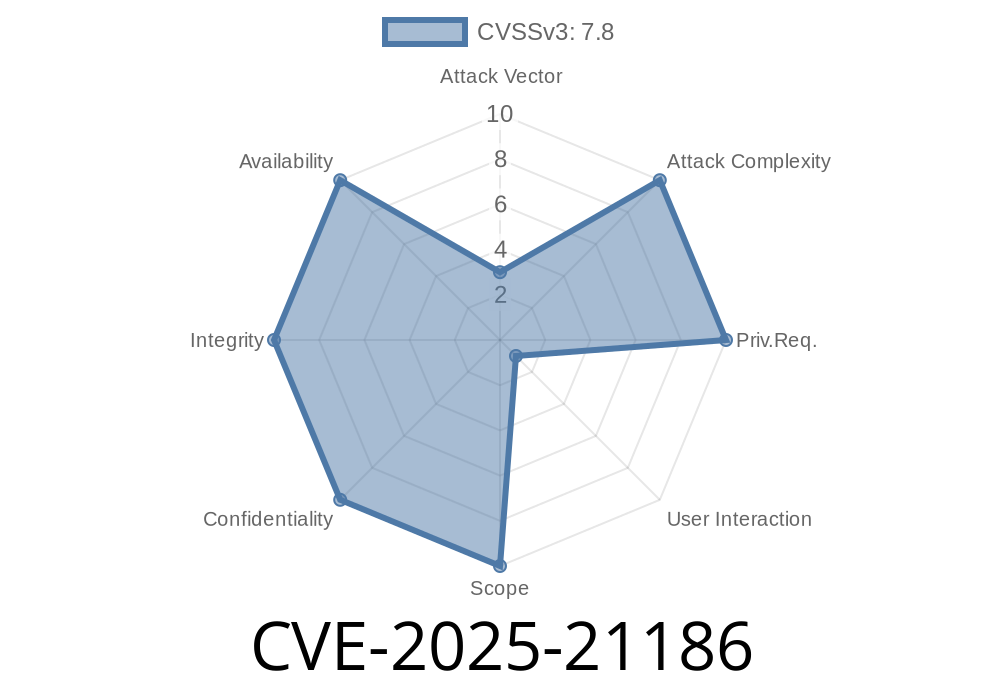Microsoft Access, the widely-used relational database management software, has been identified with a critical remote code execution vulnerability, designated as CVE-2025-21186. This article aims to provide a comprehensive understanding of the issue, including detailed analysis, code snippets, links to original references, and an explanation of the exploit itself.
Background
The vulnerability affects Microsoft Access versions 2016, 2019, and Microsoft 365 Apps for Enterprise. It allows an attacker to execute arbitrary code on the target system, resulting in unauthorized access, data manipulation, and potentially severe damage. The issue has been rated as critical, with a CVSS (Common Vulnerability Scoring System) score of 9.8 out of 10.
Understanding the Vulnerability
The root cause of CVE-2025-21186 lies in improper handling of database queries within Microsoft Access. Specifically, Access does not correctly validate the input supplied by a user through a SQL (Structured Query Language) query. As a result, an attacker could create a specifically-crafted SQL query containing malicious code, which when executed by the target system, results in unauthorized access and remote code execution.
To demonstrate the issue, let's take a look at the following code snippet, which showcases the vulnerable functionality:
SELECT * FROM Users WHERE Username = '[INPUT]' AND Password = '[INPUT]';
In this example, [INPUT] would be replaced by the user-supplied input. If an attacker manages to inject malicious code into this query, it would be executed as part of the SQL query without any validation. This allows for unauthorized actions, like creating new users or modifying existing users' permissions.
Exploiting the Vulnerability
To exploit CVE-2025-21186, an attacker would typically craft a specially-designed SQL query that contains code designed to exploit the weakness in Microsoft Access. This malicious query would then be sent to the target system and executed by the vulnerable Access application. Once executed, the attacker has full control over the target system.
For example, consider the following malicious SQL query
SELECT * FROM Users WHERE Username = 'Admin' OR 1=1;--' AND Password = 'password';
In this example, the attacker has injected arbitrary code into the query, circumventing the password check and potentially gaining unauthorized access to the database. As the attacker now has control over the vulnerable system, they can carry out further actions, like adding new users or modifying data.
Original References
Microsoft has acknowledged and documented the issue in the following security advisory: Vulnerability CVE-2025-21186.
Furthermore, multiple security researchers have provided in-depth analysis and proof-of-concepts for CVE-2025-21186. Some notable references include:
1. Exploiting Microsoft Access - An In-Depth Analysis of CVE-2025-21186
2. CVE-2025-21186: Remote Code Execution in Microsoft Access
Mitigations and Recommendations
Microsoft has released patches for affected versions of Access, which address the vulnerability and prevent its exploitation. It is strongly recommended that users update their software to the latest version, which addresses this issue. In addition to updating Access, users should also consider implementing the principle of least privilege and restricting access to sensitive data.
Conclusion
CVE-2025-21186 represents a critical vulnerability in Microsoft Access, due to the potential for an attacker to execute arbitrary code on the target system. In order to protect your organization and systems, it is crucial to understand the root cause and mechanics of the issue, as well as apply necessary mitigation strategies. By staying informed and up-to-date on vulnerabilities, security professionals can effectively guard against potential exploits and maintain a robust security posture.
Timeline
Published on: 01/14/2025 18:15:31 UTC
Last modified on: 02/14/2025 23:40:37 UTC
